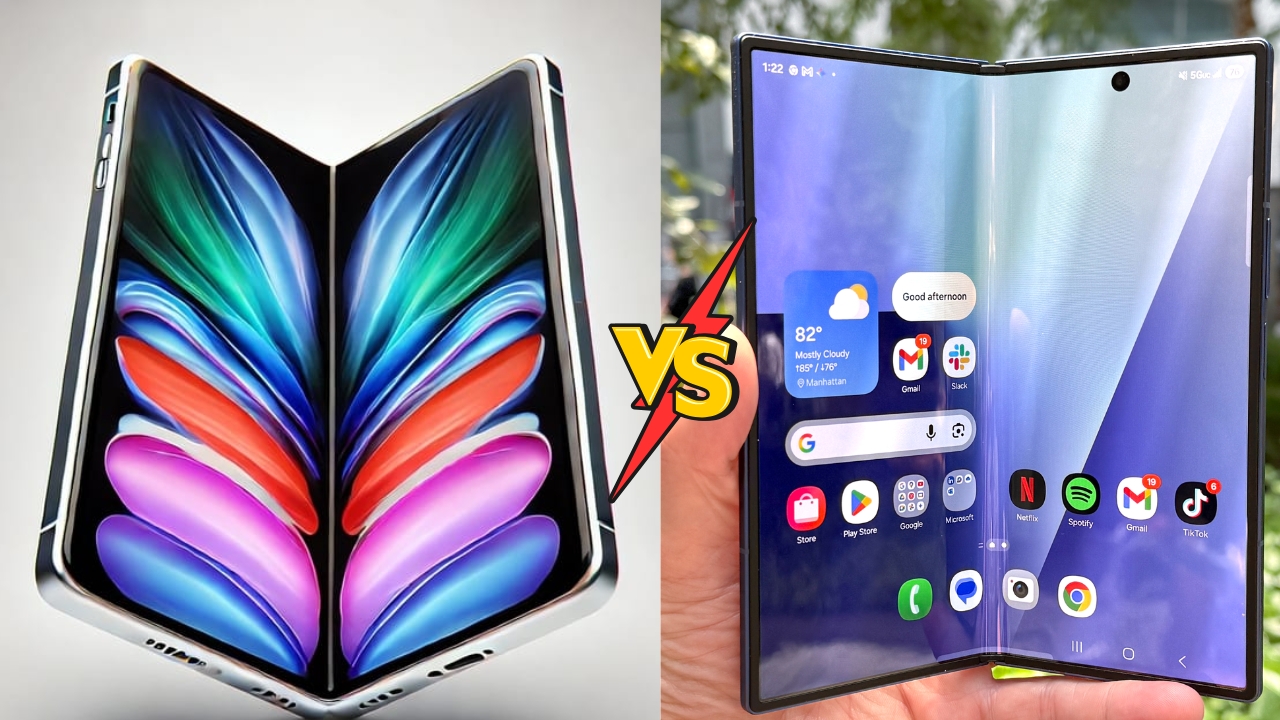2026 iPhone Fold vs Galaxy Z Fold 7: The foldable phone landscape is about to get incredibly interesting. While Samsung just dropped the Galaxy Z Fold 7 in July 2025 with some genuinely impressive upgrades, Apple is quietly working behind the scenes on what could be their most revolutionary iPhone yet. The rumored 2026 iPhone Fold promises to shake up the entire foldable market, but how will it stack up against Samsung’s latest masterpiece?
Samsung Already Redefined Compact with the Z Fold 7
Let’s talk about what Samsung achieved with the Galaxy Z Fold 7 first, because it’s genuinely remarkable. This isn’t just another incremental upgrade – Samsung basically reimagined what a foldable phone should feel like in your hands.
The Z Fold 7 measures just 8.9mm when folded and an almost unbelievable 4.2mm when unfolded. To put that in perspective, it’s barely thicker than a regular smartphone when closed and thinner than most tablets when open. At 215 grams, it’s actually lighter than Samsung’s own Galaxy S25 Ultra, which seems impossible for a device with two screens.
Samsung didn’t sacrifice durability for thinness either. The new Armor FlexHinge reduces that annoying crease that plagued earlier foldables, while Grade 4 titanium reinforcement and Gorilla Glass Ceramic 2 protection keep everything safe. The outer display now spans 6.5 inches with a more practical 21:9 aspect ratio, while the inner screen expanded to a generous 8 inches.
The camera system finally got the attention it deserved too. Samsung packed in a 200MP main sensor – the same quality you’d expect from their flagship Galaxy S series. Powered by the Snapdragon 8 Elite chipset, this thing handles everything from gaming to productivity tasks without breaking a sweat.
Apple’s Rumored Response: The 2026 iPhone Fold
Apple has been watching the foldable market develop for years, and their approach looks characteristically different. Instead of rushing to market, they’re reportedly taking time to solve the fundamental problems that have held back foldable adoption.
The rumored iPhone Fold is expected to feature a 7.8-inch inner display and a 5.5-inch outer screen when it launches in 2026. While these dimensions are slightly smaller than Samsung’s offering, Apple’s focus appears to be on creating an incredibly refined experience rather than just bigger numbers.
Here’s where things get interesting – Apple is reportedly partnering with Samsung Display for a “crease-free” solution while developing their own innovations around the hinge mechanism. They’re exploring liquid metal construction for the hinge, which could be twice as strong as titanium while allowing for better stress distribution across the display.
The titanium chassis design sounds premium, but what’s really exciting is Apple’s reported thickness target of just 4.5mm when unfolded. If achieved, this would make it even thinner than Samsung’s current achievement.
The Real Battle: Philosophy vs. Execution
Samsung’s approach with the Z Fold 7 proves they’ve mastered the hardware side of foldables. They’ve created a device that feels almost magical – genuinely thin, light, and surprisingly durable. The software experience with One UI 8 and Galaxy AI features shows Samsung understands how people actually want to use these devices.
Apple’s rumored strategy seems focused on perfecting the fundamentals before entering the market. Reports suggest they’re spending considerable time solving display creasing, developing more durable hinge mechanisms, and creating iOS features specifically optimized for foldable use. iOS 27, expected to launch alongside the iPhone Fold, will reportedly include extensive foldable-specific functionality.
The pricing expectations tell an interesting story too. Samsung kept the Z Fold 7 at $1,899, making it more accessible than many expected. Apple’s device is rumored to start around $2,000, which suggests they’re positioning it as a premium offering rather than trying to undercut competitors.
What This Means for Everyone Else
The competition between these two approaches could benefit everyone. Samsung’s proven that foldables can be incredibly thin and light without compromising functionality. Their success with the Z Fold 7 has already pushed other manufacturers to step up their game.
Apple’s eventual entry could bring the polish and ecosystem integration that might finally convince mainstream users to consider foldables. The iPhone brand still carries enormous influence, and a well-executed foldable iPhone could legitimize the entire category for millions of potential buyers.
The Practical Reality Check
Let’s be honest about what we’re dealing with here. The Galaxy Z Fold 7 exists today and represents the current pinnacle of foldable technology. You can actually buy one, use it, and experience all these impressive specifications in real life.
The iPhone Fold, despite all the excitement, remains a collection of rumors and reports. Apple’s track record suggests they’ll deliver something polished when they’re ready, but 2026 is still theoretical. We’ve seen iPhone Fold predictions come and go for years – remember when it was supposed to launch in 2022?
Even if Apple hits their 2026 target, Samsung won’t be standing still. By then, we’ll likely be looking at a Galaxy Z Fold 8 or 9 with even more refinements and innovations.
2026 iPhone Fold vs Galaxy Z Fold 7
What’s happening here extends beyond just these two devices. The smartphone industry has felt somewhat stagnant lately, with annual updates bringing incremental improvements rather than revolutionary changes. Foldables represent the first genuinely new form factor we’ve seen in years.
Samsung’s success with making foldables thin and practical proves the technology is maturing. Apple’s rumored entry suggests even the most cautious tech companies see foldables as the future rather than a novelty.
For consumers, this competition means better devices, more reasonable prices, and hopefully, solutions to the durability concerns that have kept many people away from foldables.
The 2026 iPhone Fold versus Galaxy Z Fold 7 comparison might seem premature, but it represents something bigger – the moment when foldables transition from niche gadgets to mainstream alternatives. Samsung has proven it’s possible to create genuinely compelling foldables. Now we wait to see if Apple can bring their particular brand of refinement to make them irresistible.
